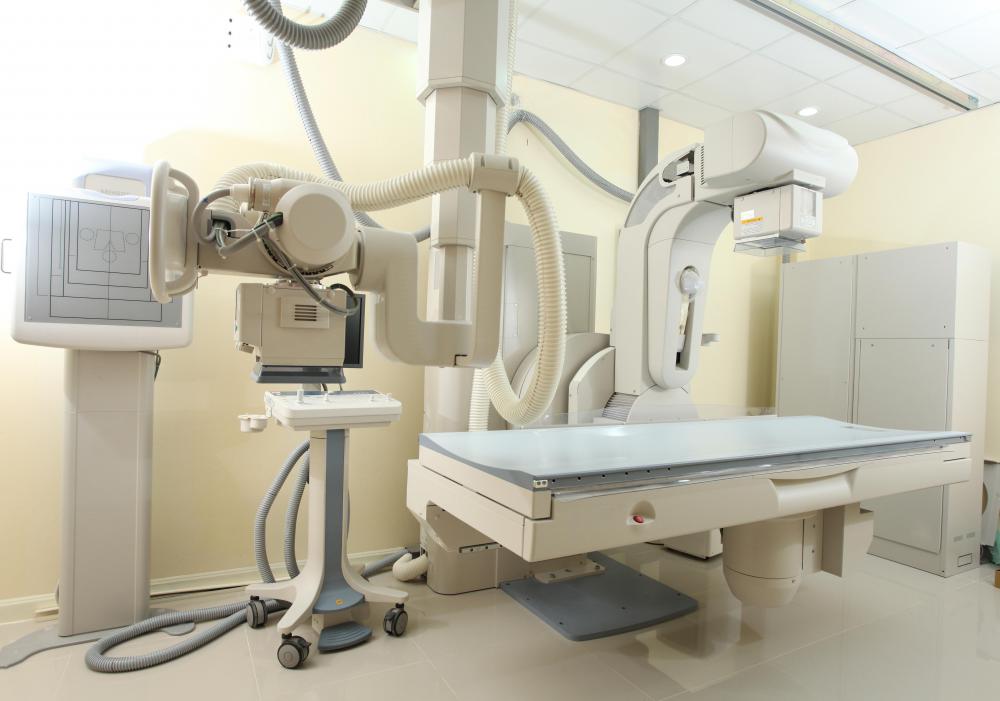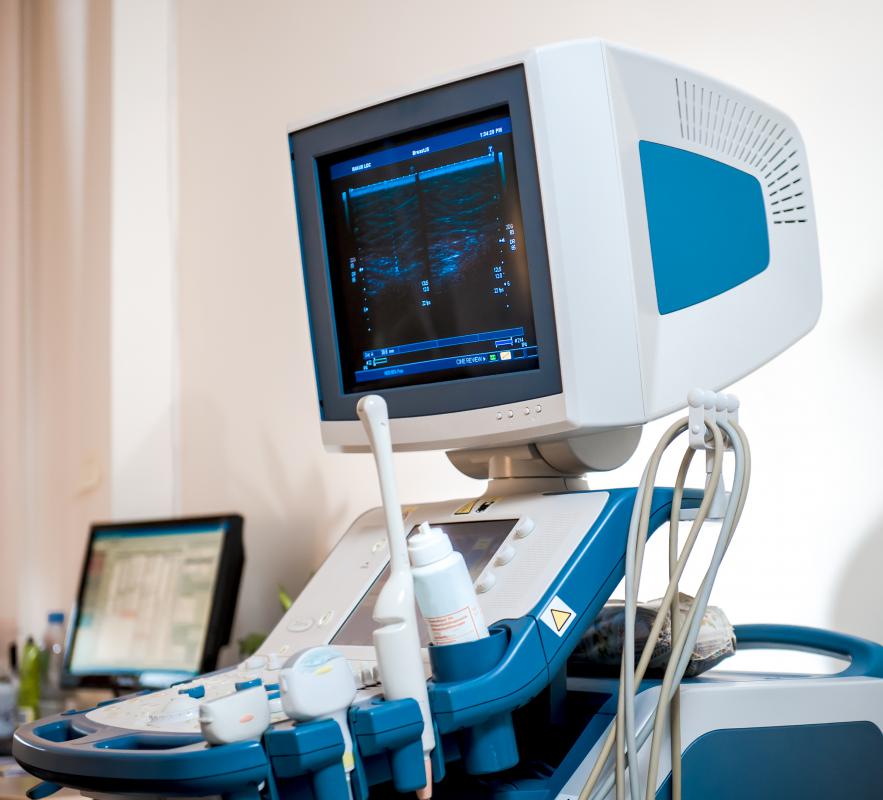At AllThingsNature, we're committed to delivering accurate, trustworthy information. Our expert-authored content is rigorously fact-checked and sourced from credible authorities. Discover how we uphold the highest standards in providing you with reliable knowledge.
What is Involved in Animal Radiography?
Animal radiography or radiology uses the same technology that is used on humans as a tool to diagnose injury and disease in animals. Veterinarians use computed tomography scans (CTs), digital fluoroscopy, nuclear imaging, ultrasound and magnetic resonance imaging (MRIs) to diagnose and treat animals, both small and large. The machines used in animal radiography are almost exactly like the machines used for humans, but many have modifications to accommodate animals of varying sizes, from hamsters to horses.
Radiography uses specific types of electromagnetic radiation to create an image. The most common type of radiography is an x-ray. The shadowy image of an x-ray is created when certain organs and bones, which are relatively dense, absorb x-rays more readily than other body parts. When exposed to the x-rays, the denser tissues or bones show up as white, while the less dense areas are black. The x-ray is perhaps one of the first tests a veterinarian will administer for a sick or injured animal in order to assess and diagnose its condition.

Animal radiography often requires modifications to human radiology equipment. For vets to perform an x-ray on a small animal, the x-ray machine can be positioned over a table, while free-floating machines can be used for larger, standing animals. A free-floating x-ray machine can move up and down, so it can also x-ray the lower extremities. This can accommodate cows, horses and other large animals.

A CT is another commonly used test in animal radiography. CTs provide hi-resolution cross section images of the inside of an animal. The image is much like an x-ray, but it is three dimensional and provides a clearer picture than a traditional x-ray.
Since an animal must lie on a table during the scan, the CT procedure poses a problem for large animals. A large animal CT table can accommodate animals up to 2,000 pounds (about 907 kg). MRIs are also used in animal radiography, but they can be very expensive and are consequently not used as often.

Digital fluoroscopy allows vets to conduct tests including venography, vascular studies and contrast GI studies. A radiocontrast agent is either injected or ingested and used to map the digestive tract or blood vessels. In nuclear imaging, vets use a gamma camera to document how a radioactive tracer that has been injected travels through the animal. In animal radiography, the camera may be attached to a stacker crane, which moves the camera up and down to scan both small and large animals.

Ultrasounds, another common test used in animal radiography, bounce sound waves off of organs and translate them into images on an ultrasound monitor. These tests are usually performed on the abdomen and thorax of animals. Because ultrasound machines are relatively mobile and easy to use, they generally don’t have to be modified for use in animal radiography.

Because animals are often uncooperative or dangerous, they are usually sedated for some of the more delicate diagnostic tests. Ultrasounds can usually be performed while the animal is awake, but if the animal is dangerous or in severe pain, the vet may administer anesthesia or a sedative to make the procedure easier on both the vet and the animal. For tests that require the patient to be still, anesthesia is usually administered in order to get a clear picture.

Like general physicians, veterinarians are trained in animal radiography, and as in human medicine, vets can also choose a specialty. One can become a board certified veterinary radiologist — a vet who studies to become a specialist in animal radiology. These specialists are available for more difficult diagnoses that require their expertise. Veterinary technicians can also specialize in small and large animal radiology by taking extra classes during their coursework.
Frequently Asked Questions
What is animal radiography and why is it important?
Animal radiography is a diagnostic imaging technique used to view the internal structures of animals. It's crucial for veterinary medicine as it allows for non-invasive examination of bones, organs, and other tissues, aiding in the diagnosis of fractures, tumors, and other conditions. This tool is vital for providing accurate treatment plans and monitoring the progress of various diseases.
How is animal radiography performed?
Animal radiography involves positioning the animal, often under sedation or anesthesia for their comfort and safety, and then using a specialized machine to emit X-rays through the body. The X-rays are captured on film or a digital sensor, creating an image that shows the contrast between different tissues based on their density and composition.
Is animal radiography safe for all types of animals?
Animal radiography is generally safe for a wide range of animals, from small pets to large livestock. However, precautions are necessary to minimize exposure to radiation. Protective measures, such as lead shields, are used, and the procedure is performed as quickly as possible to limit the dose of radiation received by the animal.
Can animal radiography detect all health issues in pets?
While animal radiography is a powerful diagnostic tool, it does not detect all health issues. It is excellent for assessing bone fractures, certain tumors, and some foreign objects, but it may not reveal soft tissue problems or specific neurological conditions. In such cases, additional imaging techniques like ultrasound or MRI may be recommended.
What should pet owners expect during their pet's radiography appointment?
Pet owners can expect a thorough explanation of the procedure from their veterinarian. Pets may need to fast before the appointment, and sedation or anesthesia is often administered for their comfort. The procedure is quick, but waiting times for results can vary. Owners should also be prepared for possible follow-up appointments or additional tests.
How has animal radiography advanced in recent years?
Advancements in animal radiography include the transition from film to digital systems, which provide higher quality images and faster processing times. Digital radiography reduces radiation exposure and allows for easier sharing of images among veterinary professionals. Innovations in portable X-ray machines have also expanded the ability to perform radiography in various settings, including field work.
AS FEATURED ON:
AS FEATURED ON:
















Discussion Comments
I have a degree in radiography and looking to get into veterinary radiography. how would i go about doing this?
Usually Radiology (X-Rays) are all done by Vet Techs.
And most VT courses are two year college courses (in Canada anyway) and focus mainly on small companion animals, meaning dogs and cats. Reptiles, birds and rodents are considered exotics and are studied minimally.
To specialize would be another course or Continuing Ed. course for that species. Many techs learn about exotics by working in an exotics clinic.
All veterinarian courses teach about all animals one may encounter, and vets are then able to specialize.
Do all vet., vet. assistant,and vet. tech. courses have to do with reptiles to or can you just do dog,cat and birds? I know you can specialize, but i mean the classes you have to take before that.
Is there a such job where you only take animal x rays or is that the job of a tech?
Post your comments